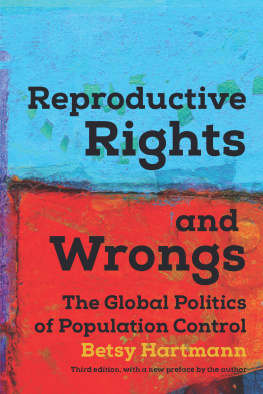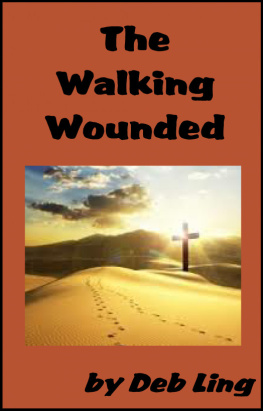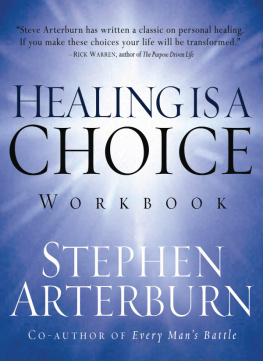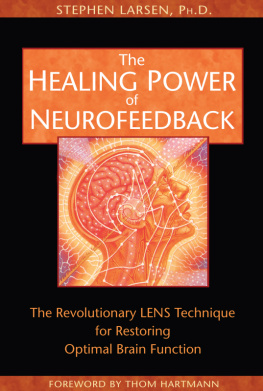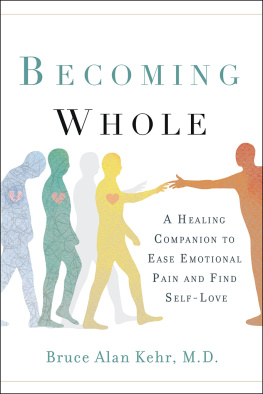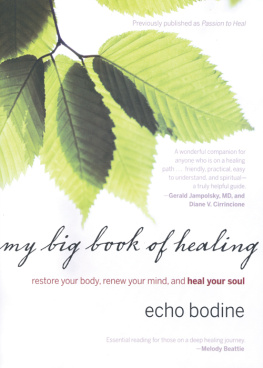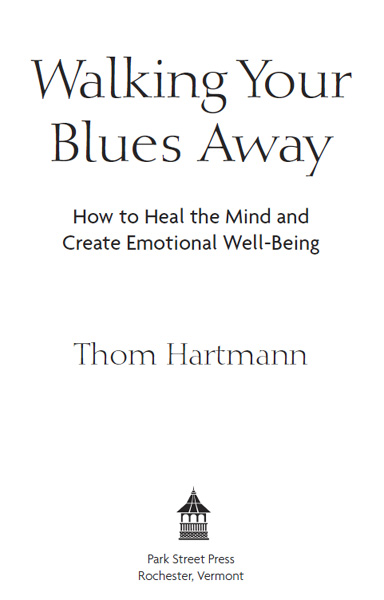
To Stan and Cindy Hartmann, with love and admiration
Walking Your Blues Away

In presenting respectable research and scholarship on how the mundane-seeming, everyday activity of walking balances the brains laterality, Thom Hartmann brings a scholars concentration to his subject, a storytellers sense of enchantment, and a humanitarians concern with the issues that matter.
STEPHEN LARSEN, AUTHOR OF
THE HEALING POWER OF NEUROFEEDBACK
Thom Hartmanns work with bilateral movement is a fascinating and important contribution to holistic healing modalities and a timely tool for healing many crises of our modern times.
JAMES ENDREDY, AUTHOR OF
ECOSHAMANISM AND EARTHWALKS FOR BODY AND SPIRIT
Acknowledgments

Special thanks in the preparation of this book go to Susan Davidson, who did an extraordinary job of editing a rough manuscript into a finished book. And to Jeanie Levitan and Jon Graham for bringing it into print. May we all walk a good long way in the journey of life...
Contents
INTRODUCTION
ONE
TWO
THREE
FOUR
FIVE
SIX
SEVEN
EIGHT
NINE
TEN
ELEVEN
AFTERWORD
INTRODUCTION

We Can (and Do!) Heal Ourselves
Healing is a matter of time, but it is sometimes also a matter of opportunity.
HIPPOCRATES
Trauma is nothing new to the human race. We are certainly familiar with trauma in the modern world, from acts of war and terrorism to crime, child abuse, and the pain our dysfunctional, standards-driven schools cause so many of our children. And many of us dont handle trauma well: suicide is the third leading cause of death among Americans ages fifteen to twenty-four.
Sociologists may argue about whether early human societies were comfortable and egalitarian, like many of the modern-day hunter-gatherer peoples living in the worlds remaining rain forests, or whether our forebears instead lived in violent dominator cultures ruled by the members who were physically strongest (the fantasy of philosophers and scientists from Rousseau in the seventeenth century to Freud in the twentieth century). However, sociologists and anthropologists and other social thinkers do not disagree that trauma and death have always been part of human life.
So how has humankind historically dealt with trauma for the past two hundred thousand years, before the advent of psychotherapy? Humans experienced mental and emotional wounds in ancient times just as we do today. Family members became sick and died; friends and family were lost to battles with other tribes and with wild animals; after the introduction of agriculture, famine and plagues were periodically visited upon us.
In times past, if four of us set out as a hunting party every few days, odds are that over time at least one person in our party would get eaten by a predator or die in an accident. When that happened right in front of the other three of us, how would we deal with the psychological trauma that resulted from witnessing such an event? We would be in a state of trauma-induced shock. How would we cope with that? How would we deal with the trauma from a near escape from death?
The answer that occurs to most people is that wed engage in some sort of ritual when we returned to the village, a ritual that usually involved drumming and dancing, two forms of bilateral activity known to induce trance. But this ceremony may have been more to help the people back in the village, such as the family of our lost companion, to work through their grief.
The human body is a self-healing organism. When you cut your finger, it heals. If you break your leg, it heals. Even if part of you is cut out in surgery, the surgeons wound heals. We heal from bacterial and viral invasions, from injuries, and from all variety of traumas. The mechanisms for healing are built into us. Five million years of evolution, or the grace of God, or both, have made our bodies automatic healing machines. So why wouldnt the same be true of our minds and emotions?
All of the traumas that we experience in life leave their wounds; if humankind hadnt had ways of healing from those emotional and psychological blows, over time society would have become progressively less functional. Instead, history shows us that people usually recover from even the most severe psychological wounds, often learning great lessons or gaining important insights in the recovery process.
The famous Kauai longitudinal study of children raised in stressful, disadvantaged conditions found that a higher percentage of the children grew up highly resilient than did a middle-class comparison group. The generation that survived the Great Depression and the Nazi Holocaust in Europe went on to create important social institutions, build nations, and offer comfort and hope to humankind. Elie Wiesels experience specifically comes to mind: although he would never have wished on another the horrific experience of being in one of Hitlers death camps, through his writing of that experience he has given a particularly inspiring model of resilience and healing to the world.
The reality is that although adversity breaks some people, it strengthens others. And when people heal from adversity, the old clich of what doesnt kill you makes you stronger usually rings true.
But, just as with the production of scar tissue in the healing of a wound to the skina process involving millions of cells producing very specific compounds in response to the trauma in the tissuethere must be an inborn mechanism for healing the mind and the emotions. And just as healing from a cut can be speeded up by keeping the wound clean and dry or can be slowed down by letting the wound get wet or dirty or irritated, this emotional healing is also a process that can be either stimulated or thwarted by our interventions.
In this book Ive identified a specific healing mechanism and process that nature has built into the human mind and body that enables us to process trauma in a way that is quick, functional, and permanent. Just like the skins mechanism for forming scabs and scars and eventually even making the scars vanish, this mechanism is simple, fundamental, and elegant.
In its simplest form, this mechanism involves rhythmic side-to-side stimulation of the body. This side-to-side motion, or bilateral movement, causes nerve impulses to cross the brain from the left hemisphere to the right hemisphere and back at a specific rate or frequency. This cross-patterning produces an organic integration of left-hemisphere thinking functions with right-hemisphere and brain-stem feeling functions. This integration is a necessary precursor to emotional and intellectual healing from trauma.
This steady movement of nerve impulses across the hemispheres of the brain is stimulated in the bilateral-movement processes of a variety of modern forms of psychotherapy, such as Eye Movement Desensitization and Reprocessing, Emotional Freedom Technique, and Thought Field Therapy. In its purest form, however, Ive discovered that the natural and rhythmic left-right-left-right process of walking, while performing a simple mental exercise, can also stimulate this same internal integration process.
Next page

